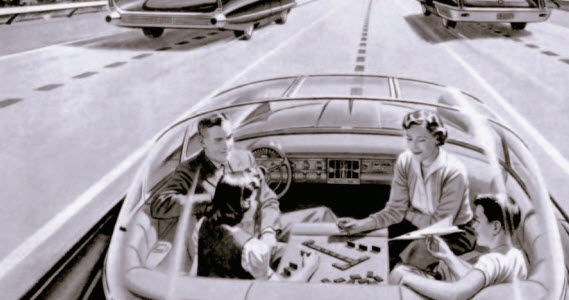Self-driving vehicles: benefits to society, policy challenges for lawmakers
January 6, 2014
Self-driving vehicles offer the promise of significant benefits to society, but raise several policy challenges, including the need to update insurance liability regulations and privacy concerns such as who will control the data generated by this technology, according to a new RAND Corporation study.
“Our research finds that the social benefits of autonomous vehicles — including decreased crashes, increased mobility and increases in fuel economy — will outweigh the likely disadvantages,” said James Anderson, lead author of the study and a senior behavioral scientist at RAND, a nonprofit research organization.
The study, intended as a guide for state and federal policymakers, explores communications, regulatory challenges and liability issues raised by autonomous vehicle technology.
Several states (Nevada, Florida, California, Minnesota) as well as Washington, D.C., have already created laws to regulate the use of autonomous vehicle technology, the researchers found. Other states also have proposed legislation. Unfortunately, this could lead to a patchwork of conflicting regulatory requirements that vary from state to state, which could undermine potential benefits, Anderson said.
Reducing crashes, energy consumption, pollution, and congestion
Cars and light vehicles equipped with this technology will likely reduce crashes, energy consumption and pollution, as well as cut costs associated with congestion. According to the Insurance Institute for Highway Safety, nearly a third of all crashes could be prevented if all vehicles had forward collision and lane-departure warning systems, side-view (blind spot) assistance and adaptive headlights. And as of March 2013, Google had logged more than 500,000 miles of autonomous driving on public roads with its driverless car without incurring a crash.
Autonomous vehicles have the potential to provide increased mobility for the elderly, the disabled and the blind. The costs associated with traffic congestion could be reduced because riders could do other tasks in transit.
Fully autonomous cars also could improve land use in several ways. Currently, about 31 percent of the space in the central business districts of 41 major cities is dedicated to parking, but autonomous vehicles would be able to drop passengers off, and then drive themselves to remote, satellite parking lots. The technology also might reduce car ownership and promote ride-sharing.
However, Anderson said that many of the benefits will accrue to parties other than the technology’s purchasers. These positive societal effects may justify some form of government subsidy to encourage more consumers to use the new technology.
Issues to work through
Negative consequences include the possibility that the technology may encourage greater travel and increase total vehicle miles traveled, leading to more congestion. If autonomous vehicle software becomes standardized, a single flaw could lead to many accidents. Internet-connected systems might be hacked by the malicious.
Researchers say there also are a number of issues that car manufacturers and policymakers will have to work through before the widespread use of driverless vehicles becomes common. While technology can sense and react quicker than humans, it is not as good at interpreting data. For example, is that object in the road a deer, a cardboard box or a bicycle? Weather, terrain and roadway signage vary across the United States — will a vehicle be able to perform in a dry, flat climate as well as a snowy one with steep hills?
Car manufacturers also will have to deal with the issue of sensor failure, Anderson said. Designing a system that recognizes when a sensor is not transmitting any information is easier than developing one that can determine when a sensor is throwing out intermittent or nonsensical data. Developing the infrastructure to allow systems such as traffic signals to communicate with these cars also will be complex and potentially costly, and making sure the technology is secure from hackers is another concern. Finally, despite growing interest in autonomous vehicle technology, it may be too expensive for widespread adoption.
The study recommends the following policy considerations:
- Policymakers should avoid passing regulations prematurely while the technology is still evolving.
- Distracted-driving laws will need to be updated to incorporate autonomous vehicle technology.
- Policymakers should clarify who will own the data generated by this technology and how it will be used, and address privacy concerns.
- Regulations and liability rules should be designed by comparing the performance of autonomous vehicles to that of average human drivers and the long-term benefits of the technology should be incorporated into determinations of liability.
The study, “Autonomous Vehicle Technology: A Guide for Policymakers,” can be found at www.rand.org.
Research for the study was funded by the RAND Initiated Research Program, using discretionary funds made possible in part by the generosity of philanthropic donors to RAND. The program is designed to fund projects that are likely to be important in the future but for which existing outside sources of funding are limited.
Abstract of RAND Corporation study
For the past hundred years, innovation within the automotive sector has created safer, cleaner, and more affordable vehicles, but progress has been incremental. The industry now appears close to substantial change, engendered by autonomous, or “self-driving,” vehicle technologies. This technology offers the possibility of significant benefits to social welfare — saving lives; reducing crashes, congestion, fuel consumption, and pollution; increasing mobility for the disabled; and ultimately improving land use. This report is intended as a guide for state and federal policymakers on the many issues that this technology raises. After surveying the advantages and disadvantages of the technology, RAND researchers determined that the benefits of the technology likely outweigh the disadvantages. However, many of the benefits will accrue to parties other than the technology’s purchasers. These positive externalities may justify some form of subsidy. The report also explores policy issues, communications, regulation and standards, and liability issues raised by the technology; and concludes with some tentative guidance for policymakers, guided largely by the principle that the technology should be allowed and perhaps encouraged when it is superior to an average human driver.
